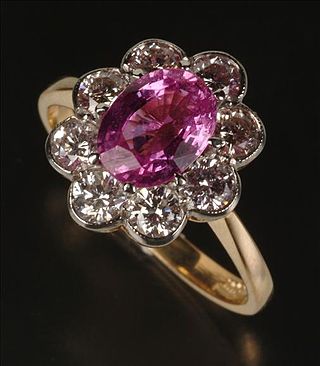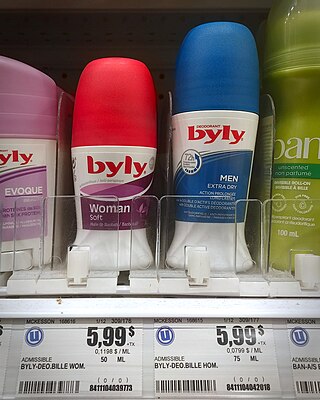Sissy, also sissy baby, sissy boy, sissy man, sissy pants, etc., is a pejorative term for a boy or man who does not demonstrate masculine traits, and shows possible signs of fragility. Generally, sissy implies a lack of courage, strength, athleticism, coordination, testosterone, male libido, and stoicism. A man might also be considered a sissy for being interested in typically feminine hobbies or employment, displaying effeminate behavior, being unathletic or being homosexual.

Tomboy is a term used for girls or young women with masculine traits. It can include wearing androgynous or unfeminine clothing and engaging in physical sports or other activities and behaviors usually associated with boys or men.

Pink is the color of a namesake flower that is a pale tint of red. It was first used as a color name in the late 17th century. According to surveys in Europe and the United States, pink is the color most often associated with charm, politeness, sensitivity, tenderness, sweetness, childhood, femininity, and romance. A combination of pink and white is associated with innocence, whereas a combination of pink and black links to eroticism and seduction. In the 21st century, pink is seen as a symbol of femininity, though this has not always been true. In the 1920s, pink was seen as a color that reflected masculinity.

Femininity is a set of attributes, behaviors, and roles generally associated with women and girls. Femininity can be understood as socially constructed, and there is also some evidence that some behaviors considered feminine are influenced by both cultural factors and biological factors. To what extent femininity is biologically or socially influenced is subject to debate. It is conceptually distinct from both the female biological sex and from womanhood, as all humans can exhibit feminine and masculine traits, regardless of sex and gender.
Gender neutrality, also known as gender-neutralism or the gender neutrality movement, is the idea that policies, language, and other social institutions should avoid distinguishing roles according to people's sex or gender. This is in order to avoid discrimination arising from the impression that there are social roles for which one gender is more suited than another. The disparity in gender equality throughout history has had a significant impact on many aspects of society, including marketing, toys, education and parenting techniques. In order to increase gender neutrality in recent years, there has been a societal emphasis on utilizing inclusive language and advocating for equality.
Gay-for-pay describes male or female actors, pornographic stars, or sex workers who identify as heterosexual but who are paid to act or perform as homosexual professionally. The term has also applied to other professions and even companies trying to appeal to a gay demographic. The stigma of being gay or labeled as such has steadily eroded since the Stonewall riots began the modern American gay rights movement in 1969. Through the 1990s, mainstream movie and television actors have been more willing to portray homosexuality, as the threat of any backlash against their careers has lessened and society's acceptance of gay and lesbian people has increased.

Children's clothing or kids' clothing is clothing for children who have not yet grown to full height. Children's clothing is often more casual than adult clothing, fit for play and rest.

A Peter Pan collar is a style of clothing collar, flat in design with rounded corners. It is named after the collar of Maude Adams's costume in her 1905 role as Peter Pan, although similar styles had been worn before this date.

Harvey Leroy Karman was an American psychologist and the inventor of the Karman cannula, a flexible suction cannula used for early-term abortions.
Toy advertising is the promotion of toys through a variety of media. Advertising campaigns for toys have been criticized for trading on children's naivete and for turning children into premature consumers. Advertising to children is usually regulated to ensure that it meets defined standards of honesty and decency. These rules vary from country to country, with some going as far as banning all advertisements that are directed at children.

Girls' toys and games are toys and games specifically targeted at girls by the toy industry. They may be traditionally associated either exclusively or primarily with girls by adults and used by girls as an expression of identity. One commentator have argued that the market for girl's toys and games is more challenging than that for boys' toys and games.
Sandra Lynn Morgen was an American feminist anthropologist. At the end of her career, she was a professor of anthropology at the University of Oregon, and previously served as vice provost for graduate studies and associate dean of the Graduate School, and director of the University of Oregon Center for the Study of Women in Society.
Pinkstinks is a campaign founded in London in May 2008 by twin sisters Emma Moore and Abi Moore to raise awareness of what they claim is damage caused by gender stereotyping of children. Pinkstinks claims that the marketing of gender-specific products to young children encourages girls to limit their ambitions later in life.

Infant clothing or baby clothing is clothing made for infants. Baby fashion is a social-cultural consumerist practice that encodes in children's fashion the representation of many social features and depicts a system characterized by differences in social class, richness, gender, or ethnicity.

Let Toys Be Toys is a campaign designed to persuade retailers to stop categorising toys by gender. It was started by a group of parents on the parenting on-line discussion forum Mumsnet.

The pink tax refers to the tendency for products marketed specifically toward women to be more expensive than those marketed toward men. This phenomenon is often attributed to gender-based price discrimination, however research shows that the primary cause is women sorting into goods with higher marginal costs. The name stems from the observation that many of the affected products are pink.
Pink and blue or Pink & Blue may refer to:

The colors pink and blue are associated with girls and boys respectively, in the United States, the United Kingdom and some other European countries.
Jeongmee Yoon is a South Korean photographer. She received an MFA in photography, video, and related media from the School of Visual Arts in 2006, and is a professor of photography at Hongik University in Seoul, South Korea.











